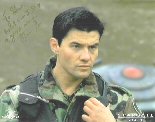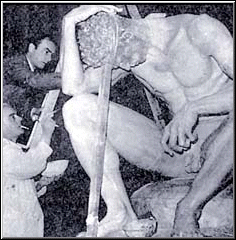 Stiff Little Fingers
Stiff Little Fingers are a
punk band from
Belfast,
Northern Ireland, formed in 1977. They started out as a schoolboy band called
Highway Star (named after the
Deep Purple song), doing rock covers, until they discovered punk. They split up after six years and four albums, although they reformed five years later, in 1987. Despite major personnel changes, they are still touring and recording
as of 2007.
Jake Burns, their lead singer, is the only member to have been with the band during all its incarnations, although in March 2006, original bass guitarist
Ali McMordie rejoined them following the departure of
Bruce Foxton after fifteen years.
Early years In the second half of 1978, they toured with the
Tom Robinson Band, and in 1979, they released their first album,
Inflammable Material. This inspired their move to
London, which led to the departure of Brian Falloon and Colin McClelland (who along with Gordon Ogilvie had been joint manager of the band up until that point).
Inflammable Material was the first album released on
Rough Trade records, and the first independent album to chart in the UK.
Jim Reilly became their drummer in time for the "Gotta Gettaway" single, and played in the
Rock Against Racism tour.
Inflammable Material In mid-1979, Stiff Little Fingers signed to
Chrysalis Records, and in 1980 released their second album,
Nobody's Heroes. 1981's
Go For It followed. Soon after the Go For It tour, Jim Reilly left the band. His place was taken by
Brian 'Dolphin' Taylor, who Jake remembered from Taylor's days with the Tom Robinson Band.
Breakup In 1982 came a 4 song EP called
£1.10 or Less and then their fourth studio album,
Now Then... (although their fifth album, as they had released a live LP,
Hanx, between
Nobody's Heroes and
Go For It). By this time they had diversified musically, and
Now Then had an almost pop feel about it in places. This led some of their more hard core punk fans to feel alienated, and in the face of low sales and concert attendances, they broke up in 1983, when Burns said: "Our last LP
Now Then was to my mind the best album we have made. But it is also unfortunately the best I think we will ever make. So I have decided to call it a day." The band later revealed the original split had been somewhat acrimonious, with bandmembers apparently having fistfights rather than talking through their differences.
Now Then They reformed in 1987; according to Burns, because they were "skint and wanted to make a bit of cash to get back to
Ireland for Christmas". They released some live albums and did short tours towards the end of the 1980s, and by 1990 were thinking of reforming permanently.
Reformation Ali McMordie decided he could not commit the time to tour full-time or record, and so left, being replaced by
Bruce Foxton (previously bass guitarist in
The Jam) in time to record 1991's
Flags and Emblems. In Britain, the single from this album, "Beirut Moon", was withdrawn from sale on the first day of release , and the trio of Jake Burns, Bruce Foxton and Dolphin Taylor continued for the next four years, joined on live shows by either
Dave Sharp or
Ian McCallum.
Flags and Emblems In 1994 they released
Get a Life in the UK, releasing it in the U.S. in 1996. By the end of 1996 Taylor left due to family commitments. Burns called in
Steve Grantley who had played drums for
Jake Burns and the Big Wheel in the late 1980s.
Get A Life The trio of Burns, Foxton and Grantley recorded 1997's
Tinderbox album, with help from Ian McCallum who joined as a full time member for 1999's
and best of all...Hope Street . This same line-up recorded 2003's
Guitar and Drum.
Tinderbox - Guitar and Drum On
January 18,
2006, the following announcement appeared on the SLF Website.
Bruce Foxton has announced that he is to leave Stiff Little Fingers with immediate effect. After 15 years of writing, recording and touring with SLF Bruce says it is time to move on and concentrate on other projects. "The situation is amicable" says Foxton. "I have enjoyed my time with Jake, Ian and Steve and will miss them. Naturally I wish them all continued success and hope to catch up with the boys during their spring tour." Obviously, we as well wish Bruce every success in everything he goes on to do in the future. He has been a fantastic asset to the band and we'll miss him as well. Jake, Steve, Ian. On
January 23,
2006, it was announced that original bass guitarist Ali McMordie was to rejoin the band for the duration of their upcoming March tour. The tour was a success, with many fans writing into SLF's message board saying how much they enjoyed it, and how fired up the band seemed to be. After much discussion regarding the status of McMordie within the band after the tour, on
21 April 2006, Burns posted the following on the message board.
"For the time being Mr. McMordie is happy to continue as long as his busy schedule allows. It may be that occasionally we have to bring on a "substitute", if he is up to his eyes and we need to do something, but hopefully we can avoid that. Cheers, Jake." Lineup change On
March 9,
2007, Jake Burns announced that Stiff Little Fingers would be recording a new album which would hopefully be completed by the end of 2007. They have previewed a track from the new album, "Liars Club", at live concerts. The track is named after a bar Jake drove past on his way home whilst listening to a press report about Tony Blair, George Bush & the Iraq War.
New Album Jake Burns -
vocals,
guitar Henry Cluney -
guitar,
vocals Brian Falloon -
drums Jake Burns -
vocals,
guitar Henry Cluney -
guitar,
vocals Ali McMordie -
bass guitar,
vocals Brian Falloon -
drums Jake Burns -
vocals,
guitar Henry Cluney -
guitar,
vocals Ali McMordie -
bass guitar,
vocals Jim Reilly -
drums Jake Burns -
vocals,
guitar Henry Cluney -
guitar,
vocals Ali McMordie -
bass guitar,
vocals Dolphin Taylor -
drums,
vocals Jake Burns -
vocals,
guitar Henry Cluney -
guitar,
vocals Ali McMordie -
bass guitar,
vocals Dolphin Taylor -
drums,
vocals Jake Burns -
vocals,
guitar Henry Cluney -
guitar,
vocals Bruce Foxton -
bass guitar,
vocals Dolphin Taylor -
drums,
vocals Jake Burns -
vocals,
guitar Bruce Foxton -
bass guitar,
vocals Dolphin Taylor -
drums,
vocals Dave Sharp -
guitar (live only, not an official band member)
Ian McCallum -
guitar {live only, not an official band member)
Jake Burns -
vocals,
guitar Bruce Foxton -
bass guitar,
vocals Steve Grantley -
drums,
vocals Dave Sharp -
guitar (live only, not an official band member)
Ian McCallum -
guitar {live only, not an official band member)
Jake Burns -
vocals,
guitar Ian McCallum -
guitar,
vocals Bruce Foxton -
bass guitar,
vocals Steve Grantley -
drums,
vocals Jake Burns -
vocals,
guitar Ian McCallum -
guitar,
vocals Ali McMordie -
bass guitar,
vocals Steve Grantley -
drums,
vocals Personnel Discography "Suspect Device", 1978
"Alternative Ulster", 1978
"Gotta Gettaway", 1979
"Straw Dogs", 1979
"At the Edge", 1980
"Nobody's Hero", 1980
"Back to Front", 1980
"Just Fade Away", 1981
"Silver Lining", 1981
£1.10 Or Less EP ("Listen"/"That's When Your Blood Bumps"/"Sad-Eyed People"/"Two Guitars Clash"), 1982
"Talkback", 1982
"Bits of Kids", 1982
"Price of Admission", 1982
"Beirut Moon", 1991
"Get a Life", 1994
"Guitar and Drum", 2004
Studio albums They also made the music for the game
Pro Pinball: Timeshock! (1997)
The Christmas Album, (1979)
Broken Fingers/Live In Aberdeen, 1979
Hanx, (1980)
All the Best, 1983
Live and Loud, (1988)
No Sleep 'Til Belfast, 1988
Greatest Hits Live, 1988
See You Up There, (1989)
Alternative Chartbusters, (1991)
Fly The Flags, (1994) (or 1991 depending on source)
Tin Soldiers, (2000)
The Radio One Sessions, (2003)
Fifteen and Counting... Live at the Barrowland 17th March 2006 Live In Aberdeen 1979, 2007)


 Catalytic processes
Catalytic processes In fiction
In fiction List of Warner labels
List of Warner labels Geography
Geography
 Composition
Composition



 Indy 500 results
Indy 500 results


 Austrian Party Platform
Austrian Party Platform The full text of the 25 point program
The full text of the 25 point program